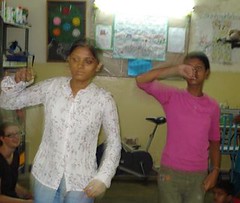 R and S are hearing impaired. R is 19 and S 14. They are both students of our special section and are real live wires. In the last years they have learnt many things from tailoring to cooking, from paper craft to weaving. R is a talented artist and S can cut and stitch a mean suit. They have evolved their won ways of communicating and have opinions on every and any thing. And yes they can even dance to the latest Bollywood number not missing a beat. R has finished training as a beautician and has a part time job at the local beauty parlour. S will also get the same training soon and join the ranks of the gainfully employed. Both are happy young girls who have taken life’s challenges in their stride.
R and S are hearing impaired. R is 19 and S 14. They are both students of our special section and are real live wires. In the last years they have learnt many things from tailoring to cooking, from paper craft to weaving. R is a talented artist and S can cut and stitch a mean suit. They have evolved their won ways of communicating and have opinions on every and any thing. And yes they can even dance to the latest Bollywood number not missing a beat. R has finished training as a beautician and has a part time job at the local beauty parlour. S will also get the same training soon and join the ranks of the gainfully employed. Both are happy young girls who have taken life’s challenges in their stride.
They both belong to poor families. S’s father is a small time tailor and R’s father keeps poor health and thus does not work much. Like for all girls in India, their parents hope to get them married one day.
A few months ago some visitors from Europe came to pwhy and were touched by these tow vibrant young ladies. They wanted to know whether there was any way in which their hearing could be restored. We had of course explored all ways when they first came to us and had been told that only a cochlear implant could help the, the boggling 1 million rupees that such an implant cost put an end to our efforts.
Last week I got a mail saying that there could be a possibility of sponsoring the implants and seeking added information. True cochlear implants are done In India at the cost of 6 to 9 hundred thousand rupees. there is an added cost of 100 000 Rs for the operation and one has speech therapy for at least two years, regular implant programming and life long annual follow ups. The operation is daunting for any one and more so for simple families who barely survive let alone live. The likelihood of these two young ladies being married in another city or village is real and that would put an end to follow ups and complex programming. The implant could become an impediment rather than an asset.
As we sat with the teachers and special educators wondering what to do, we realised that both R and S were comfortable in their silent world. They had evolved their own ways of dealing with life’s realities. They somehow were far more independent than many other young girls their age who hear but have not been educated. They have various skills and hence many avenues are open to them. A complex surgery may turn out to be a hindrance and destabilise them completely. The whopping amount spent would ultimately bring more trouble than joy.
At times like these, the existence of two Indias becomes painfully real and puts us in a disturbing dilemma. To heart or not to hear, that is the question.

